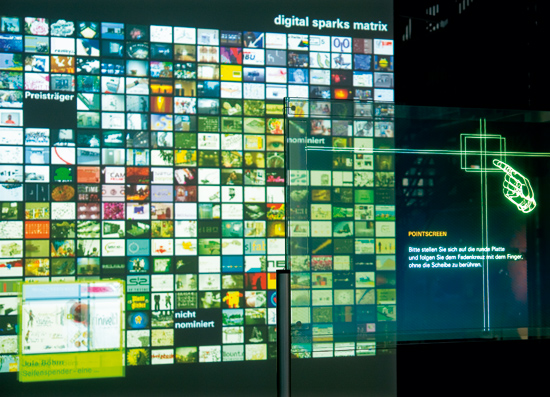NETZSPANNUNG.ORG – PERFORMING THE ARCHIVE2007 / Space- and Time Based Interfaces as Access to Online Archives netzspannung.orgMonika Fleischmann and Wolfgang Strauss  Online archives are characterized primarily by their content being distributed across hundreds of single websites; among other things, this makes the power of orientation difficult. In the installation NETZSPANNUNG.ORG – PERFORMING THE ARCHIVE, the dimension and mode of operation of the online archive netzspannung.org becomes visible. What is only sequentially perceptible on the websites and in the data bank entries of the media platform is given a new clarity by different space-and time based interfaces. NETZSPANNUNG.ORG – PERFORMING THE ARCHIVE comprises a series of works: · the media stream stands for thoughts in flux, which the viewer can stop and select. · The Digital Sparks Matrix shows a multiplicity of arranged pictures of the student competition, which can be enlarged by means of a virtual magnifying glass and easily managed with "PointScreen". With the aid of a neural net and mechanical text analysis, · the Semantic Map orders all the information on the platform and shows information as a mesh of semantic relationships. The viewers are drawn into the events through performative interfaces. In the interactive installation media stream two parallel media streams, one containing pictures and the other containing words, flow through the room as a large format data projection. The flow of words shows keywords, authors and titles of the archived documents. Via a text-to-speech process, the terms are spoken by computer voices. As index for the targeted searches, a touchscreen translates the flowing pictures into scrollable digital text banners. The media stream and its pictorial, acoustic spheres generate a knowledge space in movement. The PointScreen technology is based on so-called "Electric Field Sensing" (EFS) and uses the electro-static field of the human being in order to easily manage interactive applications. The interface takes up the motive of the matrix as an infinite ordering system. Every field of the matrix represents a media project with a pictorial icon. While the matrix supports a surveying browser, the magnifying glass offers detailed dynamic insight. For museums and archives, media stream and matrix offer a semantic map, a possibility to record, in condensed form, a large part of or even the entire itinerary and to provide a tool for detailed observation. (Monika Fleischmann and Wolfgang Strauss) · http://netzspannung.org/about/mars/projects/ · www.iais.fraunhofer.de/mars.html/ Monika Fleischmann (born 1950) is a German research artist and scientist. Since 1997 she has been the Head of Media Arts & Research Studies, the MARS – Exploratory Media Lab at the Fraunhofer IAIS Institute in Sankt Augustin, Germany. She combines conceptual and theoretical research with crossdisciplinary experience. Her main interest is to extend the concept of interaction and communication on the basis of perceptive processes. · http://www.iais.fraunhofer.de/fleischmann.html Wolfgang Strauss (born 1951) is a German architect, media artist and scientist. He studied architecture at the Hochschule der Künste in Berlin and has been head of the MARS - Exploratory Media Lab's R&D Department since 1997 for interactive and mixed-reality environments. He creates real buildings as well as electronic architecture, knowledge spaces and digital archives. · http://www.iais.fraunhofer.de/strauss.html Both are co-founder of Art+Com in 1987 and winner of the 1992 Goldene Nica of Ars Electronica for interactive art. "Digital Sparks Matrix", Installation view Photo: Marcus Meyer Monika Fleischmann/Wolfgang Strauss, NETZSPANNUNG.ORG – PERFORMING THE ARCHIVE, 2007, Space- and Time Based Interfaces as Access to Online Archives netzspannung.org, 4 Projectors, loaned by Fraunhofer Institut IAIS – MARS Lab / eCulture Factory   
|
